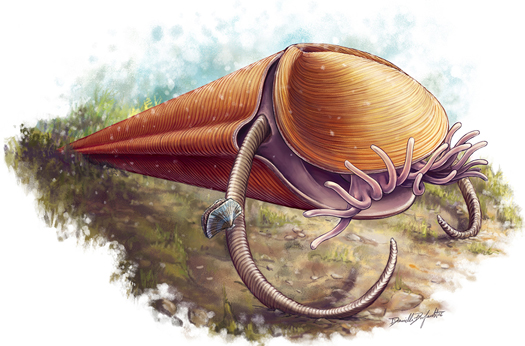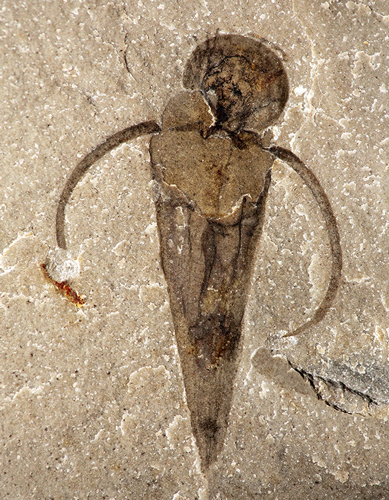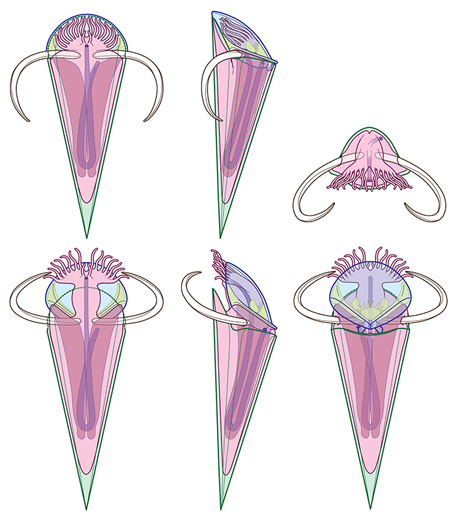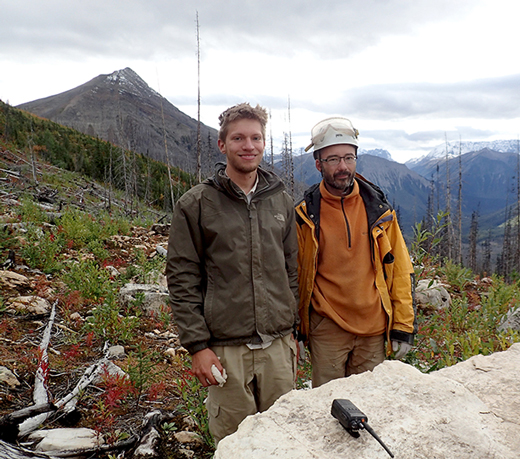Hyoliths Find a New Home
Ancient, Long Extinct Animal Finds Place on Tree of Life
A bizarre shelled marine creature’s place in the Animal Kingdom has finally been resolved thanks to the efforts of a remarkable student at the University of Toronto. Undergraduate student Joseph Moysiuk has identified Hyoliths, not as members of the Mollusca, which many palaeontologists had previously believed, but as lophophores and as such, they are closely related to brachiopods.
An Illustration of the Hyolith Haplophrentis
Picture credit: Royal Ontario Museum/Danielle Dufault
In the Hyolith illustration above, a tiny brachiopod can be seen attached to the nearest appendage of Haplophrentis.
Studying Hyoliths
The distinctive appearance and structure of the Hyolith skeleton has obstructed previous attempts to classify these animals. All Hyoliths had an elongated, bilaterally symmetrical cone-shaped shell and a smaller cap-like shell that covered the opening of the conical shell (known as an operculum). Some species also bore a pair of rigid, curved spines (helens) that protruded from between the conical shell and operculum (the shell cap), structures with no equivalents in any other group of animals.
An Extensive Fossil Record
The mineralised external skeletons (argonite) and their sessile/semi-sessile habit (living on the seabed), gives these animals, which range in size from 1 cm to around 5 cm in length, a good fossil preservation potential.
The earliest fossil evidence for this type of creature occurs in rocks dating from around 540 million years ago (Cambrian). These filter feeders seem to have persisted throughout the Palaeozoic and the Hyolith fossil record is relatively abundant and geographically widespread.
The Hyolitha were very diverse during the Cambrian and the subsequent Ordovician geological period, before their fossil record and their presence as an important member of marine benthos communities (animals and plants living on the sea floor) declines. Hyoliths are one of many types of marine invertebrate that failed to survive into the Mesozoic.
The Cambrian Hyolith Haplophrentis
Picture credit: Royal Ontario Museum
Diverse in the Palaeozoic
In the picture of a Hyolith fossil above, (genus Haplophrentis – H. carinatus), the conical shape of the shell can be clearly made out and the partially extended lophophore (feeding organ) can be seen. The lophophore consisting of numerous, blackened, thin, finger-like extensions is highlighted against the operculum. The curved spines are the helens.
Writing in the academic journal “Nature”, student Joseph Moysiuk and his fellow authors, Durham University’s Martin Smith and Burgess Shale fossil expert Jean-Bernard Caron, studied over 1,500 fossil specimens from the mid-Cambrian strata that represent elements of the Burgess Shale (British Columbia) and the Spence Shale Formations (Idaho and Utah). The Hyolith material (Haplophrentis) and its exceptional state of preservation permitted the team to assess the soft tissue structures and from this information the team were able to deduce their taxonomic affinities.
Dr Caron explained:
“Burgess Shale fossils are exceptional because they show preservation of soft tissues which are not usually preserved in normal conditions.”
Not Closely Related to Snails, Cephalopods and Other Molluscs
The analysis showed that Hyoliths are not closely related to snails, squid or other members of the Mollusca. They are instead, more closely related to the Brachiopoda, a group of animals with a rich fossil record but with few extant representatives. Brachiopods have a soft body enclosed between upper and lower shells (valves), unlike the left and right arrangement of valves in bivalve molluscs. Brachiopods open their valves at the front when feeding but otherwise keep them closed to protect their feeding apparatus and other body parts.
Student Moysiuk commented:
“Our most important and surprising discovery is the Hyolith feeding structure, which is a row of flexible tentacles extending away from the mouth, contained within the cavity between the lower conical shell and upper cap-like shell. Only one group of living animals – the brachiopods, has a comparable feeding structure enclosed by a pair of valves. This finding demonstrates that brachiopods, and not molluscs, are the closest surviving relatives of Hyoliths.”
The undergraduate added:
“It suggests that these Hyoliths fed on organic material suspended in water as living brachiopods do today, sweeping food into their mouths with their tentacles,”
A Diagram Showing the Proposed Anatomy of a Hyolith
Picture credit: Royal Ontario Museum/Danielle Dufault
The Function of the Helens
Examination of the orientation of the helens in multiple Hyolith specimens from the Burgess Shale suggests that these spines may have been used like stilts to lift the body of the animal above the sediment, elevating the feeding apparatus to enhance feeding.
Dr Caron led recent field exhibitions to the Burgess Shale. This resulted in the discovery of many specimens that form the basis of this research. The key specimens came from recently discovered deposits near Stanley Glacier and Marble Canyon in Kootenay National Park, about twenty miles south-east of the original Burgess Shale site in Yoho National Park.
Exploring the Burgess Shale
Picture credit: Joseph Moysiuk
Solving a Puzzle
Palaeontology lecturer Martin Smith expressed his delight at being able to help solve a 175-year-old palaeontological puzzle. Hyolith fossils have been included in a number of fossil studies previously, but until now, where these creatures featured in the tree of life remained open to speculation.
Dr Smith stated:
“Resolving the debate over the Hyoliths adds to our understanding of the Cambrian Explosion, the period of rapid evolutionary development when most major animal groups emerge in the fossil record. Our study reiterates the importance of soft tissue preservation from Burgess Shale-type deposits in illuminating the evolutionary history of creatures about which we still know very little.”
Everything Dinosaur acknowledges the assistance of the University of Toronto in the compilation of this article.
Visit the Everything Dinosaur website: Everything Dinosaur.





